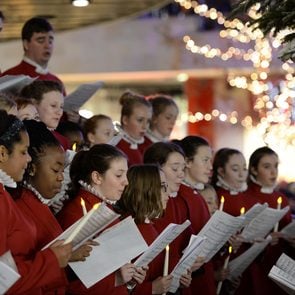Who is Santa Claus, Anyway?

Our modern day version of Santa is actually a combination of various legends and traditions from around the world.
The original Santa Claus can be traced back to 4th-century Hagios Nikolas, the bishop of Myra in Turkey. He became famous for his generous gifts to the poor. One popular legend had him tossing bags of gold through a window for three poor women to use as dowries. After his death in 335 A.D., he was canonized as the Patron Saint of Giving. Throughout the Middle Ages, St. Nicholas gathered many followers, eventually becoming the patron saint of Greece and Russia, as well as Amsterdam. To this day, in celebration of his memory, gifts are given out on his feast day, December 6.
In 1822, Clement Moore published his famous A Visit From St. Nicholas (known more popularly these days as The Night Before Christmas), inspired by an article by the poet Washington Irving. But it was political cartoonist Thomas Nast who created the modern Santa Claus we know and love. In 1862, Nast drew Santa for the cover for Harper’s Weekly. Nast’s Santa was a kindly figure in a fur-lined suit visiting troops on the Civil War battlefield. The image stuck and Nast drew the annual Harper‘s Santa cover until 1886, adding the sleigh, reindeer and his home at the North Pole.
Who is Santa Claus Around the World
Although St. Nicholas inspired the man who is Santa Claus in North America, the character takes different names (and forms) across the globe:
- Brazil and Peru: Papa Noel
- China: Shengdan Laoren
- England: Father Christmas
- Finland: Joulupukki
- France: Pere Noel
- Japan: Santa no ojisan (Uncle Sanata)
- Germany: Christkindl
- Italy: Babbo Noel
- Ireland: Aither Nollaig
- Latin America: el Niño (the infant Jesus)
- Netherlands: Kerstman or Sinterklaas
- Norway: På Norsk
- Sweden: Jultomten
- Russia: Ded Moroz (Grandfather Frost)
Kris Kringle
In North America, “Kris Kringle” is used interchangeably with Santa, thanks in part to the classic Christmas movie, Miracle on 34th Street—but Kris Kringle represents a departure from the St. Nicholas origin story. The name itself is a mispronunciation of “Christkindl”—German for Christ Child. Introduced by Martin Luther to counteract the popularity of St. Nicholas, this figure takes on Santa’s role of gift-giver to children in Austria and Switzerland. (If “Christkindl” sounds somewhat familiar, it’s with good reason: German-style Christmas markets—now popular across Canada—are often known as “Christkindl Markets.”)
Sinterklaas
When they settled New Amsterdam (now New York), the Dutch brought their patron saint with them. Sinterklaas (also known as Sint-Nicolaas) wore a broad brimmed hat and smoked a long pipe. Along with his assistant, Black Pete, he arrives by ship to hand out gifts.
Now that you know who Santa is, check out Canada’s most magical Christmas markets.






